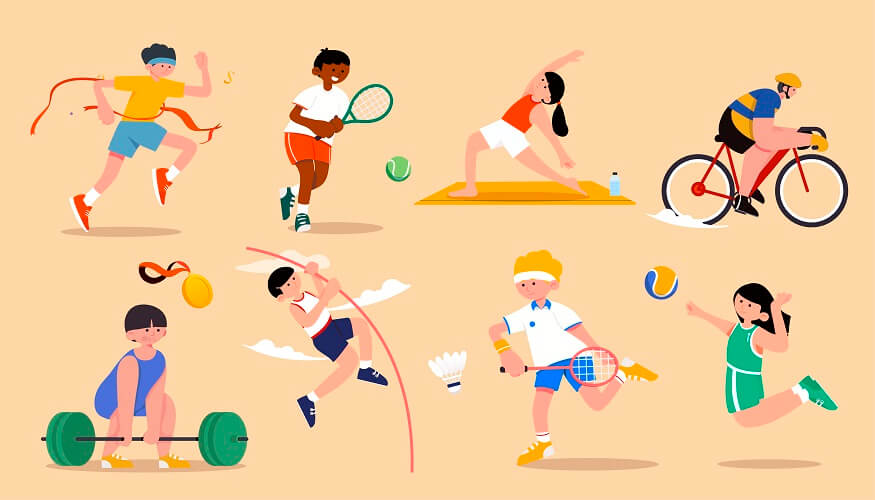The Indispensable Role of Physical Education in Schools

Technology has changed the way we learn, making it easier to access information and resources. But, as a consequence, students are spending more time sitting in front of screens, which means they’re not getting enough exercise.
In India, where academic success is very important, physical education is not always considered a top priority in schools. However, it’s important to include physical education in the curriculum to help students develop in a well-rounded way. But how’s that even possible?
Let’s learn through this blog.
Benefits of Physical Education: Why School Curriculum Must Have Physical Education
Physical education is not just an extracurricular activity; it’s a vital component of a well-rounded education. The advantages of physical education extend far beyond the obvious physical health benefits. Here’s why it is essential in schools:
Encouraging Healthy Habits:
Physical education is important for developing healthy habits from an early age. Students learn the significance of being active and fit by participating in different physical activities.
Improving Mental Health:
Regular physical activity is known to have a positive impact on mental health. It can uplift mood and provide a sense of well-being. This is particularly significant for students who often face stress and anxiety.
Boosting Academic Performance:
Studies have shown that physical activity can improve brain function, concentration, and memory, which are all critical for academic success.
Enhancing Social Skills:
Physical education classes offer an opportunity for social interaction and learning valuable life skills such as teamwork, leadership, and communication. These skills are important for both personal and professional growth.
Building Self-Confidence:
Achievements in sports and physical activities can boost a child’s self-esteem and confidence. Every goal scored, race won, or personal record broken contributes to their sense of accomplishment.
Promoting Inclusivity and Equality:
Physical education provides an inclusive environment where students of all abilities can participate and succeed. This teaches the value of equality and respect for others, irrespective of their physical abilities.
How the Physical Education Gap Affects Students
Physical education in schools is very important for students, as it helps them in various ways. Not having them can lead to a lot of problems, such as
- Rising Health Concerns:
- Impaired Cognitive Function:
- Social Skill Deficit:
- Increased Stress and Anxiety:
- Lack of Engagement in School Activities:
- Reduced Exposure to Diverse Interests:
The absence of physical education leads to a sedentary lifestyle among students, increasing the risk of obesity, cardiovascular diseases, and other health issues.
If students don’t engage in physical activities, their cognitive functions can be affected, which may lead to difficulties in learning and problem-solving.
Without the collaborative environment provided by physical education, students may miss out on developing crucial social skills such as teamwork and communication.
Physical activity is a natural stress reliever. The absence of it can lead to increased levels of anxiety and stress among students, which can have far-reaching impacts on their mental health and academic performance.
If students don’t participate in physical education, they may not feel engaged in school activities, leading to absenteeism and lower school spirit.
Physical education exposes students to a variety of sports and activities, helping them discover new interests and passions. Without this exposure, students may miss out on finding activities that they enjoy and excel in.
Components of Physical Education
Physical education is a subject that involves a lot of different things that help students grow and develop. It’s not just about playing sports! Some of the things that students learn in physical education classes include:
- How to move their bodies in different ways, like running, jumping, throwing, and catching.
- How to stay healthy and fit by doing exercises that make their bodies stronger, more flexible, and better at breathing.
- How to understand the rules of different sports and games, and how to play them well.
- How to work with others as a team, and how to be a good sport when they win or lose.
- How to make friends and get along with others by interacting and playing with them.
- How to take care of their bodies by eating healthy foods and drinking enough water.
Physical Education in India: How Schools Should Approach
Schools in India need to rethink their approach to physical education, which is often limited to mandatory classes. Here are some strategies that schools can implement to improve physical education:
- Physical education should be considered an extension of academics and not separate from it. Schools can reinforce concepts from science, math, and languages through active games and physical activities.
- Every child has different physical abilities and interests. Schools should offer a variety of sports and activities that cater to different preferences and skill levels.
- Teachers play a crucial role in the implementation of effective physical education programs. Regular professional development can equip them with the latest techniques and knowledge to engage students.
- Well-maintained sports equipment, safe play areas, and technology like fitness trackers or interactive games are essential for a successful physical education program.
- Physical education should aim to instill a love for fitness that extends beyond school. Schools could incorporate lessons on the importance of staying active throughout life, including activities that can be continued independently as adults.
- Educating parents about the importance of physical education and involving them in school fitness events can create a supportive environment for students.
- Schools should provide education on nutrition, mental health, and lifestyle choices, creating a well-rounded curriculum that addresses all aspects of health.
The purpose of physical education goes beyond promoting physical fitness; it is about nurturing the overall well-being of students. Schools should adopt innovative and inclusive physical education programs that cater to the interests and abilities of all students, ensuring that each child is engaged and benefiting from the physical education experience.
Billabong International High School understands the critical role of physical education in nurturing well-rounded, healthy, and intellectually vibrant students. We invite you to explore our dynamic physical education program that balances academic rigor with physical wellness. To learn more about our curriculum, contact us today.













